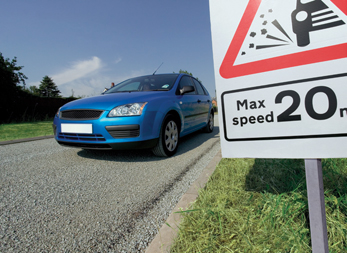This section covers
This section covers

Whatever the weather, make sure your vehicle and equipment are in good condition and regularly checked and serviced.
In bad weather the condition of your vehicle is even more important, especially your tyres and brakes.
Different weather conditions can lead to a variety of different hazards, both from season to season and from region to region.
Check tyre condition and pressures frequently. Make sure that the tyres have a good tread, that the walls are undamaged and that they’re inflated to the correct pressure.
Also check your tyres for uneven wear of the tread, either across or around the tyre, which could be due to a mechanical defect. Have your vehicle checked, any fault put right and a new tyre fitted if necessary.
Good tyres are especially important in snow, on icy roads and in heavy rain. Be prepared; don’t wait until the bad weather shows up the deficiency – it might be too late, and your life could depend on a few millimetres of rubber which should have been there.
Keep your brakes in top condition. Stopping takes much longer on wet, slippery roads, even with perfect brakes.
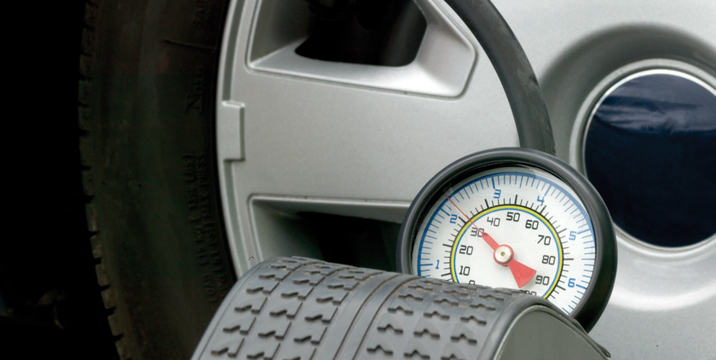
The biggest single danger to any driver is being unable to see properly. You won’t be able to make the right decisions if you can’t see the road clearly.
Always keep your windscreen, mirrors and windows clean and clear.
Make sure your wiper blades are effective.
Make sure washers are working and keep the reservoir filled. Use an additive, as it helps
•to prevent freezing in winter
•to clear dead insects and smears off the windscreen in summer.
Misting up of the mirror and glass inside the car affects your ability to see. Even on a summer’s day a sudden shower can make the glass mist up inside.
•Keep a dry cloth handy and clean all inside glass.
•Wipe the windows dry before you set out.
•Use your demisters. If your car has a heated windscreen, use it early. Also, use your heated rear window to maintain your rear vision.
•Open your windows to clear mist, if necessary.
•If your car is fitted with air conditioning, this can assist with clearing windows.
Read your vehicle handbook and follow the maker’s suggestions for effective heating and ventilation.
Many anti-mist and anti-frost accessories are available, including
•liquid for keeping glass clear
•de-icers
•prepared cloths
•electrically heated glass.
Warm, dry air works best, is by far the cheapest and is usually in plentiful supply once the engine has warmed up.
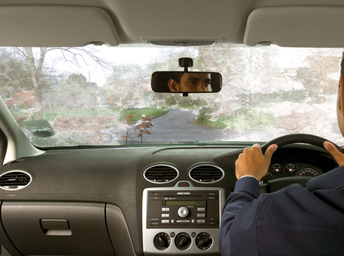
Wait until the windscreen has cleared completely before pulling away.
However, when you start from cold, you won’t be able to create warm air so use a dry cloth or a chamois leather. If you have a passenger, ask them to help keep side windows clear – this is essential when manoeuvring.

If the weather is particularly icy, your windows and windscreen can be frozen over.
Give yourself plenty of time to clear the windscreen. Before setting out, wait until your demister and heater are working well enough to keep the whole of the windscreen and rear window clear.
Take care not to damage wiper blades, which may have frozen onto the windscreen or rear window. Never use boiling water to clear the windscreen; you could break the glass. Use water that’s barely lukewarm or even cold – this is still warmer than ice and will start the defrosting process.
Use dipped headlights in poor visibility (such as rain, drizzle, mist, or very poor light) so that other drivers can see you.
Rain can drastically reduce your view through the windscreen and windows and in the outside driving mirrors.
The cleaner the glass, the sooner the wipers can clear the outside of the screen. Always keep the washer bottle topped up.
Keep your speed down in very wet weather. Some windscreen wipers aren’t efficient enough to deal with very heavy rain.
In dirty weather conditions, clean your windscreen, windows, indicators and lights as often as necessary.
Remember, whatever the weather, don’t drive unless you can see properly all around.
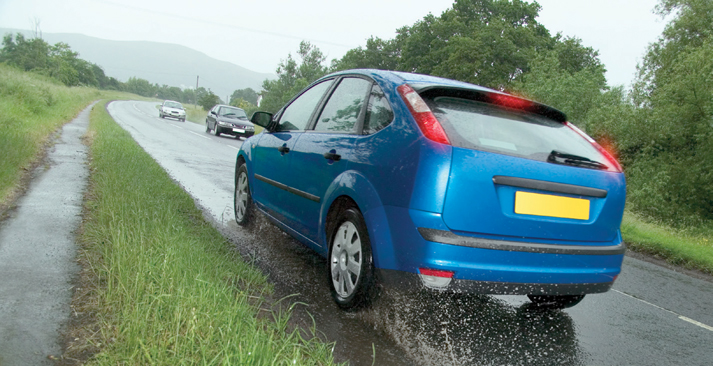
Wet roads reduce tyre grip, so slow down. Give yourself plenty of time and room for slowing down and stopping. Keep well back from other vehicles. On a wet road, you should allow at least double the braking distance for a dry road.
After a spell of dry weather, rain on the road can make the surface even more slippery. Take extra care, especially when cornering. Be aware that different road surfaces might affect the grip of your tyres.
Remember, the less tread on your tyres, the greater the increase in braking distance.
Consider others Pedestrians and cyclists can easily get drenched by passing vehicles. Look well ahead and show consideration by slowing down or giving them more room when it’s safe to do so. Also give cyclists room to pull out to avoid large puddles.
A great danger when driving at speed in very wet weather is the build-up of water between the tyre and the road surface. As a result your vehicle actually slides forwards on a thin film of water as your tyres lose contact with the road surface. This is called aquaplaning. Even good tyres can’t grip in this situation.
A clear indication that you’re aquaplaning can be that the steering suddenly feels very light. When this happens, slow down by easing off the accelerator. Never brake or try to change direction, because when you’re aquaplaning, you’ve no control at all over steering or braking.
The higher your speed on a wet road, the more likely you are to aquaplane. You must keep your speed down and watch for water pooling on the road surface.
Even at lower speeds, if the front and rear tyres on one side of the vehicle hit a patch of deeper water, the vehicle may swerve because of the additional resistance on that side.
Another reason for keeping your speed down on wet roads is the amount of water thrown up by other vehicles.
Overtaking or being overtaken by heavy vehicles on a motorway can be an unnerving experience.
If necessary, slow down to increase the distance between you and the large vehicle, remembering to look in your mirrors before you do so.
Sometimes wipers can’t keep the windscreen clear even when working at full speed. This results in the driver being temporarily blinded to conditions ahead; you may need to slow down.
If water sprays up under the bonnet, it can stop the engine or affect the electronic controls.

When you have to pass through a flood, take your time. Stop and assess how deep the water is. Don’t just drive into it. Some roads that are likely to flood have depth gauges. Check the depth on these.
Deep water If the water seems too deep for your vehicle, turn back and go around the flood by another road. It might take a little longer, but that’s better than finding yourself stranded.
If the water is too deep it could
•flood the exhaust, causing the engine to stop
•find its way into the air intake on some vehicles, causing serious engine damage.
Shallow water If the water isn’t too deep, drive on slowly but be sure to keep to the shallowest part. Remember, because of the camber of the road, the water is probably deepest near the kerb and shallowest at the crown.
Driving through floodwater Drive in first gear as slowly as possible but keep the engine speed high and steady by slipping the clutch.
•If the engine speed is too low, you might stall.
•If you go too fast, you could create a bow wave. Water will flood the engine and it could cut out.
Try to strike a balance.
Engines and water Some types of diesel engine will tolerate a certain amount of water, but many modern fuel systems are electronically controlled and are, therefore, affected by water.
All petrol engines can be seriously affected by even small amounts of water being splashed onto the electrical components; these can include engine management systems, coil, distributor, leads and so on.
The depth of water at a ford varies with the weather and is usually greater in winter. There may be a depth gauge in the area. If the water isn’t too deep for your vehicle, cross using the same technique as you would for a flood.
Remember to test your brakes after you cross. There might be a notice reminding you to do so.
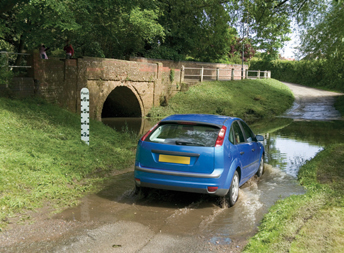
Don’t try to displace the water by ‘charging’ at the flood or ford.
•You could lose control.
•Your vehicle will probably stall.
•You could end up blocking the road.
Water can reduce the effectiveness of your brakes, so test your brakes whenever you’ve passed through water on the road. When you’ve driven safely through, check your mirrors first and then test your brakes.
If they don’t work properly, it will help to dry them out if you apply light pressure to the brake pedal while driving along slowly. Don’t drive at normal speed until you’re sure they’re working properly.
Some vehicles can become unstable in strong crosswinds (or side winds), because of their large surface area and comparatively low weight.
This can happen particularly on exposed stretches of road such as motorways, viaducts and bridges.
The effect can vary from a slight pull on the steering wheel to a distinct wander, possibly into the path of another vehicle.
In very bad cases, the whole vehicle can be lifted bodily off the road with very serious results.
In gusty conditions, watch for cyclists or motorcyclists being blown sideways and veering into your path. Allow extra room when overtaking.
Drivers of high-sided vehicles, or those towing caravans, trailers or horseboxes (particularly empty ones) should
•pay special attention to forecasts of strong winds
•avoid well-known trouble spots and high bridges.
Drivers of these vehicles should be constantly alert for the effects of wind near bridges and embankments, even on normal journeys in reasonable conditions. If there’s a severe weather warning, consider if your journey is really necessary.
Other drivers should bear this in mind when about to overtake, or when being overtaken by, these particular types of vehicle.

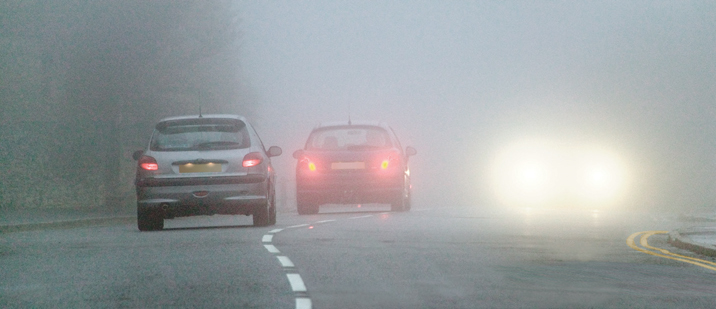
Fog is one of the most dangerous weather conditions. An incident involving one vehicle can quickly involve many others, especially if they’re driving too close to one another.
Motorway pile-ups in fog have sometimes involved dozens of vehicles. All too often there’s a loss of life or serious injury that could easily have been prevented.
Observe the obvious It doesn’t need a sign to tell you it’s foggy if you can only see a short distance ahead!
Take alternative transport or postpone your journey, if at all possible. If you must drive, give yourself time to prepare.
Remember, if the fog is thick and you can see the rear lights of the vehicle ahead, then you may be too close to stop in an emergency.
Check all lights, clean your windscreen, and so on. Allow more time for the journey.
Correctly adjusted fog lights can be a valuable aid when driving in fog.
In daylight You MUST use your dipped headlights when visibility is seriously reduced.
•They’ll be seen from a much greater distance than sidelights.
•They won’t dazzle other drivers or pedestrians in the daytime.
You could also consider using dipped headlights, or at least sidelights, in relatively light fog. Remember that, even if you think you can see far enough ahead, your own vehicle might not be clearly visible to others until you’re too close. If in any doubt, always try to maximise your visibility in the interests of safety.
Use fog lights if your vehicle is fitted with them.
At dusk Use dipped beams at dusk and other times when visibility is poor.
At night In darkness you might need to depend entirely on fog lights, or alternate between fog lights and dipped beams through stretches of thick and thin fog.
High-intensity rear fog lights If your vehicle has high-intensity rear fog lights, use them in fog only when visibility is seriously reduced. Normally this means when you can’t see for more than 100 metres (328 feet).
Remember, you MUST switch fog lights off when visibility improves – it’s the law. Using them at other times, such as in the rain, can dazzle drivers behind you.
Adjust your lights Change your lighting with the conditions. For example, when you’re queuing in traffic and the driver behind has already seen you, it can be helpful to switch off your rear fog lights temporarily to avoid dazzling them.
Poor visibility is frustrating and a strain on the eyes. Your ability to anticipate is dangerously restricted. It’s also much more difficult to judge distances and speed in fog when outlines become confusing. You can easily become disoriented – especially on an unfamiliar road.
In the interests of safety, you MUST
•slow down – check the speedometer from time to time
•be able to stop well within the distance you can see to be clear
•use your windscreen wipers to keep the outside of the screen clear
•use your demister to keep the inside of the screen clear. Use your heated windscreen if your vehicle has one.
Fog itself doesn’t claim lives, but the standard of driving in fog results in death and destruction which could have been avoided.
Do
•give yourself plenty of time and space to deal with whatever is ahead. Decide what’s a safe speed for the conditions and stick to it. Don’t let other drivers push you into driving faster
•watch out for emergency vehicles. There could well be an incident ahead.
Don’t
•follow the vehicle in front too closely
•try to keep up with the vehicle ahead. You’ll get a false impression that the fog isn’t too bad if you ‘hang on’ to the lights of the vehicle ahead because it will displace some of the fog
•use main beam when you’re in fog as the fog reflects the light and can dazzle you, reducing your visibility even further. It can also dazzle other drivers.
Fog patches The density of fog varies. Sometimes the fog is patchy. One moment it can be fairly clear, the next extremely dense. Avoid the temptation to speed up between the patches.
Following another vehicle Slow down and leave plenty of room for stopping. There may be something ahead which you can’t possibly see until you’re too close to it.
If the vehicle ahead has to stop suddenly, you must leave enough time to react and brake.
You may not see or recognise that the vehicle ahead is braking or has stopped as soon as you would in clear weather.
You need to be able to brake safely, so remember the road surface is often slippery in fog.
Overtaking Overtaking in fog can be particularly dangerous. You could well find that visibility ahead is much worse than you thought, and you won’t be able to see oncoming traffic soon enough.
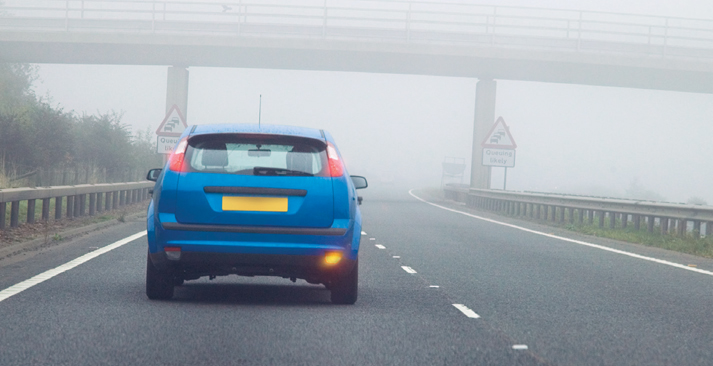
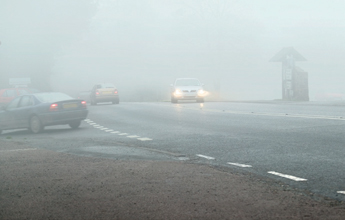
Dealing with junctions in fog needs particular care, especially when turning right. You should
•open your window(s) and switch off your radio/CD player so you can hear any approaching traffic
•start indicating as early as you can
•make the greatest possible use of your lights. If you keep your foot on the brake pedal while you’re stopped, your brake lights will give drivers behind an extra warning
•use the horn if you feel it will help, and listen for other vehicles.
Don’t turn or emerge until you’re absolutely sure it’s safe.
Road markings Dipped headlights will pick out reflective studs, but it’s not so easy to recognise other road markings when driving in fog. Explanations of the different coloured studs are given on page 112.
Remember, motorcyclists can be much more difficult to see in fog as they have only one headlight and tail light.
Try to keep a central position between lane lines or studs. Don’t mix up lane lines and centre lines. Driving too close to the centre could mean you’re dangerously near someone coming the other way who might be doing the same thing. Driving on the centre line as a means of finding your way is extremely dangerous.
Parking Never park on a road in the fog if you can avoid it. Find an off-street parking place. However, if it’s unavoidable, always leave your parking or side lights on.
Don’t leave dipped headlights or the main beam on. In foggy conditions, these can lead other road users to wrongly think they’ve drifted over to the extreme right-hand side of the road. If they quickly try to correct this positioning in order to keep to what they think is the left-hand side, they would mount the pavement.
This would be very dangerous for any pedestrians and other road users nearby. There might also be damage to walls, properties, street furniture and other vehicles. In rural areas there might be a ditch instead of a path, or even an embankment leading down to water.
Breaking down If you break down, get your vehicle off the road if you possibly can. Inform the police, and make arrangements to remove it as soon as possible if it creates an obstruction. Never leave it without warning lights of some kind, or on the wrong side of the road.
In winter, especially if the weather doesn’t look good, check the local weather forecast before setting out. If snow or ice is forecast, don’t drive unless your journey is essential.
If you consider it necessary to travel, it’s useful to carry the following in case you get stuck or your vehicle breaks down
•warm drink and emergency food
•warm clothing and boots
•de-icer/ice scraper
•torch
•first aid kit
•spade or shovel
•jump leads
•blanket
•old sacks.
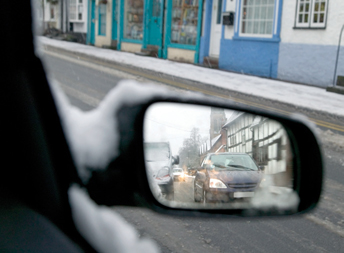
You should also
•clear all snow and ice from all of your windows so that you can see clearly all round
•ensure all lights are clean and free from snow so they can be seen by other road users
•make sure the mirrors are clear and the windows are demisted thoroughly so that you have the best visibility possible
•clear snow from the bonnet and roof so that it doesn’t fly off and cause a danger to other road users such as motorcyclists or cyclists.
If you experience wheelspin when you’re starting off in deep snow, don’t race the engine because the wheels will dig in further.
Try to move the car slightly backwards and then forwards out of the rut. Use the highest gear you can.
In these conditions, it’s worthwhile carrying a spade and some old sacks. These can be useful to help get you going when you’ve become stuck in snow.
Snow chains are available which can be fitted over existing wheels and tyres to help avoid getting stuck and to reduce the danger of skidding.
When falling snow reduces visibility, use your dipped headlights as you would in heavy rain or fog. Falling or freshly fallen snow need not cause too much difficulty, providing you remember to
•increase the gap between you and the vehicle in front, remembering to look in your mirror before slowing down
•test your brakes, very gently, from time to time, but be sure to look in your mirrors before braking. Snow can pack behind the front wheels or around brake linkages under the car and so affect steering and braking
•be prepared to clear the windscreen by hand. Your wipers, even with the aid of the heater, may not be able to sweep the snow clear. Snow might collect and pack around your lights and indicators
•drive with care, even if the roads have been treated. Conditions can change over very short distances
•try to find out about weather and traffic conditions ahead by listening to travel bulletins on the radio and noting any information on the variable message signs.
In areas that are subject to prolonged periods of snow, it may be an advantage to fit
•snow chains (attachments which fit over existing wheels and tyres)
•mud and snow (M and S) tyres with a tread pattern designed for these conditions.
Snow will cover up road markings – take care when you can’t see which road has priority.
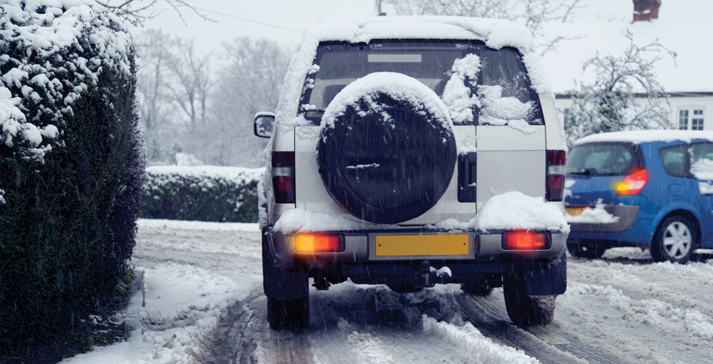
Overnight freezing usually results in an icy surface, especially on less-used roads. Look for signs of frost on verges, etc.
It’s even more dangerous when the roads are just beginning to freeze or thaw. The combination of water and ice adds up to an extremely slippery surface.
Rain freezing on roads as it falls (black ice) is an invisible danger. As with aquaplaning, your steering will feel especially light.
When driving on ice
•you need to keep your speed down
•treat every control – brakes, accelerator, steering, clutch and gears – very delicately.
If it’s very cold, treat all wet-looking surfaces as though they’re frozen because they probably are. If the road looks wet but there’s no sound from the tyres, expect ice.
All but the most gentle braking will lock your wheels on packed snow and ice.
If your front wheels lock, you can’t steer. If you can’t steer, you can’t keep out of trouble.
For vehicles without ABS brakes, in slippery conditions, repeatedly applying and releasing the brakes will slow the vehicle down and enable you to keep control.
Using this method will allow some degree of steering control.
Get into a lower gear earlier than normal. Allow your speed to fall and use the brake pedal gently and early to keep your speed well under control.
Braking distances Braking distances on ice can easily be 10 times normal distances.
Downhill braking Downhill braking calls for careful speed control well before reaching the actual hill, as well as while you’re on it.
By selecting a low gear, the engine compression will help to hold the vehicle back and reduce the overall speed.
Anti-lock brakes ABS may reduce the risk of vehicle instability when braking on snow and ice. However, they can’t compensate for poor judgement or excessive speed. They won’t help your tyres stay in contact with the road surface in ice or snow.
Time your driving and adjust your speed so that you don’t have to use your brakes at all on a bend.
Approach a corner at a steady speed, using as high a gear as you reasonably can.
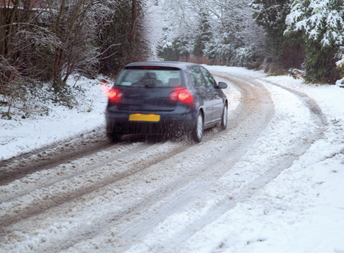
•Be gentle with the accelerator.
•Don’t use the clutch unless you absolutely have to.
•Steer smoothly – sudden movements must be avoided.
•Take just as much care coming out of a turn.
Braking on an icy or snow-covered bend is extremely dangerous. The centrifugal force will continue to pull you outwards and the wheels won’t grip very well. This could cause your vehicle to spin.
Speed must be kept down on icy and slippery roads. But this can bring with it other problems.
For example, when going uphill you might lose momentum. Trying to regain speed and keep going could cause severe wheelspin and loss of control.
If you have to stop, it could be difficult to start again.
Leave a good gap between you and the vehicle in front. If it stops you’ll at least have a chance to keep going while it restarts, or even pass it altogether.
To reduce the chances of wheelspin, use the highest gear you reasonably can.
Don’t rush a hill thinking you’ll change down on the way up. Before reaching the hill, get into a gear that will take you all the way up.
Changing gear isn’t easy on an icy slope. It takes very delicate footwork to avoid wheelspin and loss of speed.
If a vehicle heading towards you is obviously out of control, try to make maximum use of engine braking if there’s time. If you must use the brake pedal, be as gentle as possible.
Avoid braking and steering at the same time to get out of the way. Both are dangerous in icy conditions.
Constantly assess what’s ahead. Be prepared, and look for escape routes.
Bright sunshine and hot weather
Before you begin a long journey, make sure you’re prepared for the weather.
Tyres Tyre pressures should be checked and adjusted when they’re cold.
Don’t check the pressure when you’ve been driving for a while because tyres will be warm and the reading will be inaccurate.
Coolant Before you start your journey, check the level of coolant in the system.
Clear windscreen There are generally more flies and insects about in hot weather, and your windscreen needs to be kept clean.
Keep the windscreen as clear as possible of water and grease marks. This helps to cut down glare.
Check the level in the washer reservoir and top up if necessary. Using an additive may help to keep the windscreen clean.
Glare One of the main problems when driving in sunny conditions is glare. This can seriously reduce your ability to see.
Reduce speed and take extra care. If the roads are wet, reflected glare can increase the problem.
Drive slowly and carefully if you’re being dazzled by bright sunshine. Watch out particularly for pedestrians and cyclists, and make sure you can stop quickly if necessary.
Constant sun in your eyes can be exhausting on a long journey and may well affect your concentration.
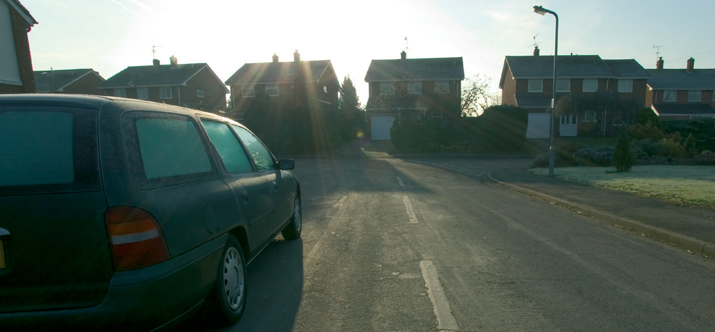
Even if you don’t feel the need for them, the correct sunglasses can reduce the glare and keep your eyesight effective for longer. This is especially important if you’re driving abroad, where conditions are hotter and the sunlight brighter than you may be used to.
Low-angle sun Glare can be worse in the winter when the sun is low in the sky. Wear sunglasses and/or use your visor to cut out as much glare as possible. Avoid looking directly into the sun.
Make sure you use adequate ventilation inside the car. Air conditioning helps, if you have it. Take plenty of breaks and refreshment on a long trip.
If you feel sleepy, stop and rest where it’s safe. Never stop on the hard shoulder of a motorway when you feel tired. Use the service areas or get off the motorway.
Listen to travel information and try to avoid known traffic hold-ups.
Overheated engines in long traffic queues are the most frequent causes of breakdowns in these conditions.
Soft tarmac During long periods of hot weather, many tarmac road surfaces become extremely soft. Take care when braking and cornering.
Oil Oil and water can make the hot surface of the road slippery and dangerous, particularly if there’s a sudden rain shower after a long dry spell.
Take extra care; watch your speed and keep your distance.
Loose chippings Many highway authorities replace the granite chipping road surfaces during the summer. Always observe the special warning speed limits and keep well back from the vehicle in front.
Flying stone chips can cause not only expensive damage to your vehicle, but also serious injury to pedestrians and other road users.
